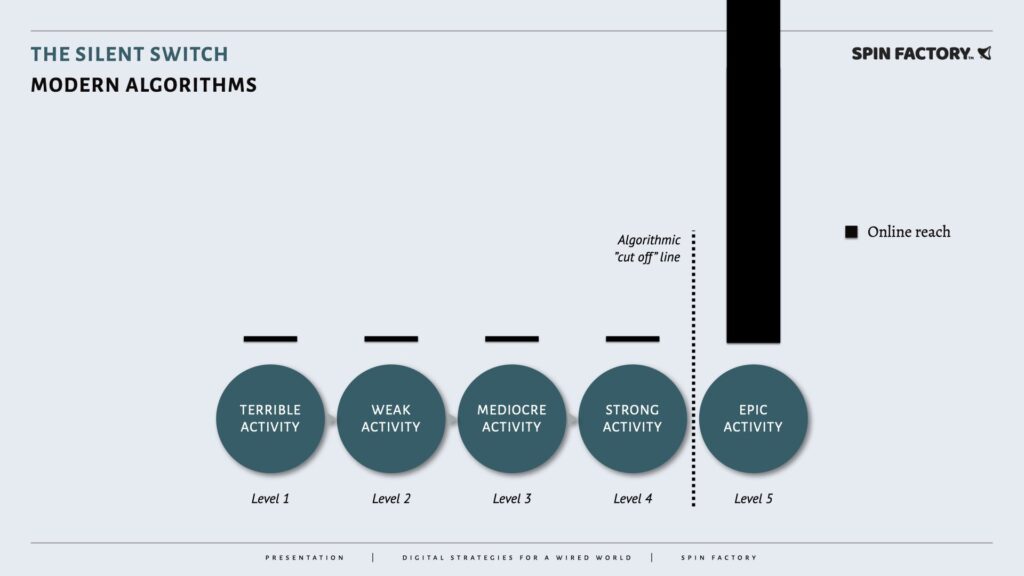Let’s explore the different graphs of algorithms.
To the uninitiated, an algorithm might seem as daunting as deciphering hieroglyphs or navigating the shifting paths of a quantum universe.
Yet, at their core, algorithms are just a series of graphs, elegant recipes of the computational world, marrying logic and creativity in a mathematical dance, orchestrating our world’s technologies from the shadows.
What are these graphs — and what can they do?
Here we go:
The Secret Architects of the Digital Epoch
In the gentle hum of the 21st-century landscape, in the silhouettes of the tall server racks and the twinkling lights of the ever-ubiquitous smartphones, one finds the quiet pulse of a new global life force: the algorithm.
Unseen yet omnipresent, algorithms are the secret architects of our digital lives, underground labyrinths of cable and invisible tsunamis of radiowaves, extending tendrils into every corner of our existence.
An algorithm could be as simple as sorting a list of numbers or as complex as a multi-layered deep neural network trained to recognize human faces in a bustling crowd.
As we navigate the complexity of this digital epoch, it’s our responsibility to ensure that the vast potential of these algorithmic leviathans is harnessed to illuminate the human experience, not to shroud it.
The Paradoxical Power of Algorithms
In today’s world, algorithms propel us into the digital age. They filter the news we read, optimize our travel routes, suggest the music we listen to, and even find romantic partners.
Algorithms are the puppeteers behind the grand spectacle of online advertising, deciding in split seconds which ads to show us based on an intricate tapestry of data points. The world of finance, too, has bowed to their reign, with algorithmic trading becoming the pulsating heartbeat of Wall Street.
The power algorithms hold is immense and, quite possibly, beyond our comprehension. They’re no longer just tools for executing mundane tasks; they’ve evolved to learn, predict, and, in a sense, understand. In light of rapid developments in AI, who knows what the multiplier will be?
They offer a mirror to our collective psyche, capturing patterns in our behaviour, our desires, and our fears. Yet, therein lies the paradox. This power — beautiful and terrifying — can be wielded for the greater good or serve as a conduit for manipulation, reinforcing biases, and infringing on privacy.
Who knows?
Shaping Norms and Sculpting Futures
The might of today’s algorithms is their ability to sort, recommend, filter, and personalise and their capacity to sway human behaviour and subtly sculpt societal norms. The precise measure of their influence is still being unravelled.
Yet, what is beyond doubt is that our lives have become entwined with these mathematical minotaurs. We live in a world painted with broad strokes of human creativity but filled in with the delicate brushwork of algorithms.
In the grand scheme of human existence, the algorithm’s reign is relatively nascent, and our society is still grappling with the implications of its influence. As we look towards a future where algorithms will undeniably play a central role, it becomes more crucial than ever to understand their power and to ensure their use is transparent, fair, and beneficial for all.
Their ethereal whispers, reverberating through the circuits of the digital cosmos, must be guided by the principles of humanity as they continue to write the story of our era.
The Architecture of Graphs and Networks
Amid the flux of bytes and pixels, our collective consciousness is emerging, shaping and shaping a new architecture. It is an architecture of graphs and networks, mapping our desires and curiosities, fears and friendships, commerce and culture.
Akin to the star maps that once guided explorers through vast, uncharted seas, these graphs chart the vast and ever-expanding seas of data, serving as celestial compasses for the titans of the digital realm — the search engines, the social networks, the behemoth online services that boast user bases as populous as nations.
Each click, each like, each share and tweet weaves into an intricate tapestry of user data, providing these digital giants with a wealth of insights to maximise their long-term business potential, simultaneously shaping our digital interactions and reflecting our collective desires.
When viewed through the lens of the seven types of graphs, this data forms the skeleton key to our digital identities.
Enter: The 7 Graphs of Algorithms
Spin Academy | Online PR Courses
Types of Algorithm Graphs
Search engines, social networks, and online services typically have a wealth of user data to optimise the user experience.
Here are examples of different types of graphs that social media algorithms use to shape desired behaviours:
The different graphs are typically weighted differently. For instance, some media companies allow a fair degree of social graph content, while others offer almost none. Changes are constantly being enforced, and the silent switch might be the most notable example of a media company shifting away from the social graph. 1Silfwer, J. (2021, December 7). The Silent Switch — A Stealthy Death for the Social Graph. Doctor Spin | The PR Blog. https://doctorspin.net/silent-switch/
The media company can leverage these graphs using two main approaches:
Today, profiling seems to be the dominant approach amongst media companies.
Learn more: The 7 Graphs of Algorithms: You’re Not Unknown
💡 Subscribe and get a free ebook on how to get better PR.


THANKS FOR READING.
Need PR help? Hire me here.

PR Resource: The Silent Switch
The Silent Switch
All social media algorithms are built differently and are constantly being developed. At the same time, social media users’ behaviours are evolving.
Still, there was a way that social media algorithms used to behave—and there is a way that social media algorithms behave now.
This has been a fundamental but silent switch.
How Social Media Algorithms Used To Behave
For more than a decade, social media algorithms would deliver organic reach according to a distribution that looked something like this:
This distribution of organic reach enabled organisations to use social media despite not being “media companies.”
How Social Media Algorithms Behave Today
Today, after the silent shift, social media algorithms deliver organic reach more like this:
The increased competition and sophistication among content creators partially explain this new type of distribution. However, going viral is still just as possible for anyone.
How does this work?
The Single Content Algorithm
How can a social network predict what users will like?
Content from a trusted creator trusted by a large community of followers used to be the leading indicator of future performance. But today, social networks have found a better way to predict content success.
The single content algorithm = when social networks demote content creator authority to promote single content performance to maximise user engagement for ad revenue.
The single content algorithm presents newly published content to a limited audience sample size:
If the newly published content tests successfully, the social media algorithm pushes that content to a slightly larger statistical subset. And so on.
This iterative process means that single pieces of content worthy of going viral will go viral, a) even if it takes a longer time, and b) regardless of the content creator’s number of followers.
Learn more: The Silent Switch
Annotations
| 1 | Silfwer, J. (2021, December 7). The Silent Switch — A Stealthy Death for the Social Graph. Doctor Spin | The PR Blog. https://doctorspin.net/silent-switch/ |
|---|





